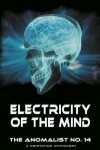Instant CPR for the Head
November 10, 2010
 We now have some reviews of the 14th issue of the Anomalist journal, entitled Electricity of the Mind, to share with you. Peter Rogerson, in his review of the book for Magonia, does a wonderful job of linking most of the contents of this volume of essays to a common theme: “Texts contain hidden secrets, and new technologies are helping to unearth them. Older texts may contain the strangest stories and the ones that require the most textual analysis to help tease out their meaning.” He ends his review with these fine words: “As always in the Anomalist the good stuff far outweighs the dross, and recommended to all Forteans and explorers of the matrix of ghosts.” Tom Ruffles, in his review of the book for the Society for Physical Research, picked out his two favorite essays: “There are two stand-out papers here, one by Theo Paijmans, the other by Mike Jay. Paijmans … gives us … some fine examples of how searching newspaper runs digitally can assist in uncovering stories. A major benefit of this is the ability to check huge quantities of text quickly, throwing up variants of the same story in different publications…The always reliable Mike Jay looks at Coleridge…[and] concludes that Coleridge, being poised to elaborate a new psychology, then drew back, perhaps because he found it beyond his capabilities, though he incorporated these insights into his wider literary theories. The main point was that imagination was not mechanical but was fluid, capable of synthesis and recombination.” Finally, Paul Sieveking of the Fortean Times chose to highlight another essay in his review of the book: “This latest Anomalist anthology offers a wide range of short(ish) articles to stimulate the fortean imagination…The most contentious contribution is a piece by ‘Aeolus Kephas’ exploring the implications of treating anthropologist Carlos Castaneda and alien abductee Whitley Strieber as genuine witnesses of shamanic phenomena, conduits for superior intelligence. This is an intriguing thought experiment, but I still suspect The Teachings of Don Juan and Communion are ingenious fiction rather than travelogues from the Land of Magonia. However, this anthology deserves a place on every fortean’s bookshelf.” So, thank you, Ian Simmons, who did such a bang-up job as the guest editor on this volume!
We now have some reviews of the 14th issue of the Anomalist journal, entitled Electricity of the Mind, to share with you. Peter Rogerson, in his review of the book for Magonia, does a wonderful job of linking most of the contents of this volume of essays to a common theme: “Texts contain hidden secrets, and new technologies are helping to unearth them. Older texts may contain the strangest stories and the ones that require the most textual analysis to help tease out their meaning.” He ends his review with these fine words: “As always in the Anomalist the good stuff far outweighs the dross, and recommended to all Forteans and explorers of the matrix of ghosts.” Tom Ruffles, in his review of the book for the Society for Physical Research, picked out his two favorite essays: “There are two stand-out papers here, one by Theo Paijmans, the other by Mike Jay. Paijmans … gives us … some fine examples of how searching newspaper runs digitally can assist in uncovering stories. A major benefit of this is the ability to check huge quantities of text quickly, throwing up variants of the same story in different publications…The always reliable Mike Jay looks at Coleridge…[and] concludes that Coleridge, being poised to elaborate a new psychology, then drew back, perhaps because he found it beyond his capabilities, though he incorporated these insights into his wider literary theories. The main point was that imagination was not mechanical but was fluid, capable of synthesis and recombination.” Finally, Paul Sieveking of the Fortean Times chose to highlight another essay in his review of the book: “This latest Anomalist anthology offers a wide range of short(ish) articles to stimulate the fortean imagination…The most contentious contribution is a piece by ‘Aeolus Kephas’ exploring the implications of treating anthropologist Carlos Castaneda and alien abductee Whitley Strieber as genuine witnesses of shamanic phenomena, conduits for superior intelligence. This is an intriguing thought experiment, but I still suspect The Teachings of Don Juan and Communion are ingenious fiction rather than travelogues from the Land of Magonia. However, this anthology deserves a place on every fortean’s bookshelf.” So, thank you, Ian Simmons, who did such a bang-up job as the guest editor on this volume!
Now Available: Electricity for the Mind: The Anomalist 14
March 30, 2010
 It took us a year and a half to get this one out, but we think you’ll find it was worth the wait. Ian Simmons, who edited the last issue of Fortean Studies, was our guest editor this time around and he did a fabulous job. He calls this issue, our 14th, Electricity of the Mind – instant CPR for the head. Inside you’ll find this tantalizing line-up of articles: Theo Paijmans mines the rich seam of digital newspaper archives to look at anomalies in a whole new way. Ulrich Magin ventures into a previously neglected corner of Earth Mysteries, taking us on a tour of out-of-place volcanoes across Europe. Dwight Whalen explores a forgotten tale of bizarre visions that brought vivid omens of World War I to the skies of Pennsylvania in 1914. Cameron Blount examines the implications of archaeological relics of Peru’s mysterious Moche culture and what they might tell us about the neighboring Nazca culture. Mike Jay discusses Samuel Taylor Coleridge’s lasting and deep interest in the supernatural. Bryan Williams, Annalisa Ventola, and Mike Wilson provide a basic primer for exploring temperature and magnetic fields in cases of haunting. Patrick Gyger uses the “Black Books” of Fribourg to understand the mindset behind witch trials in the late 15th Century. Aeolus Kephas looks at the similarities between two of the 20th Century’s most popular and charismatic “literary shamen”: Carlos Castaneda and Whitley Strieber. John Caddy seeks a common root behind the various biological energies not known to science on which many esoteric knowledge systems rely. Chris Payne takes a new mathematical approach in trying to determine whether there are still Thylacines out there. Mark Pilkington takes a look back into the prehistory of crop art and reveals a thought-provoking precursor from the movies. Gary Lachman shares his previously unpublished notes from his book Politics and the Occult. Richard Wiseman, Professor of the Public Understanding of Psychology, recounts his discovery of the first ever film of a magic trick. And last but not least, Tim Cridland, whose stage name is Zamora the Torture King, takes a long, hard look at the career of leading skeptic James Randi. Altogether this issue is sure to spark your imagination!
It took us a year and a half to get this one out, but we think you’ll find it was worth the wait. Ian Simmons, who edited the last issue of Fortean Studies, was our guest editor this time around and he did a fabulous job. He calls this issue, our 14th, Electricity of the Mind – instant CPR for the head. Inside you’ll find this tantalizing line-up of articles: Theo Paijmans mines the rich seam of digital newspaper archives to look at anomalies in a whole new way. Ulrich Magin ventures into a previously neglected corner of Earth Mysteries, taking us on a tour of out-of-place volcanoes across Europe. Dwight Whalen explores a forgotten tale of bizarre visions that brought vivid omens of World War I to the skies of Pennsylvania in 1914. Cameron Blount examines the implications of archaeological relics of Peru’s mysterious Moche culture and what they might tell us about the neighboring Nazca culture. Mike Jay discusses Samuel Taylor Coleridge’s lasting and deep interest in the supernatural. Bryan Williams, Annalisa Ventola, and Mike Wilson provide a basic primer for exploring temperature and magnetic fields in cases of haunting. Patrick Gyger uses the “Black Books” of Fribourg to understand the mindset behind witch trials in the late 15th Century. Aeolus Kephas looks at the similarities between two of the 20th Century’s most popular and charismatic “literary shamen”: Carlos Castaneda and Whitley Strieber. John Caddy seeks a common root behind the various biological energies not known to science on which many esoteric knowledge systems rely. Chris Payne takes a new mathematical approach in trying to determine whether there are still Thylacines out there. Mark Pilkington takes a look back into the prehistory of crop art and reveals a thought-provoking precursor from the movies. Gary Lachman shares his previously unpublished notes from his book Politics and the Occult. Richard Wiseman, Professor of the Public Understanding of Psychology, recounts his discovery of the first ever film of a magic trick. And last but not least, Tim Cridland, whose stage name is Zamora the Torture King, takes a long, hard look at the career of leading skeptic James Randi. Altogether this issue is sure to spark your imagination!









